Kyoto’s best locations to see beautiful fall colors
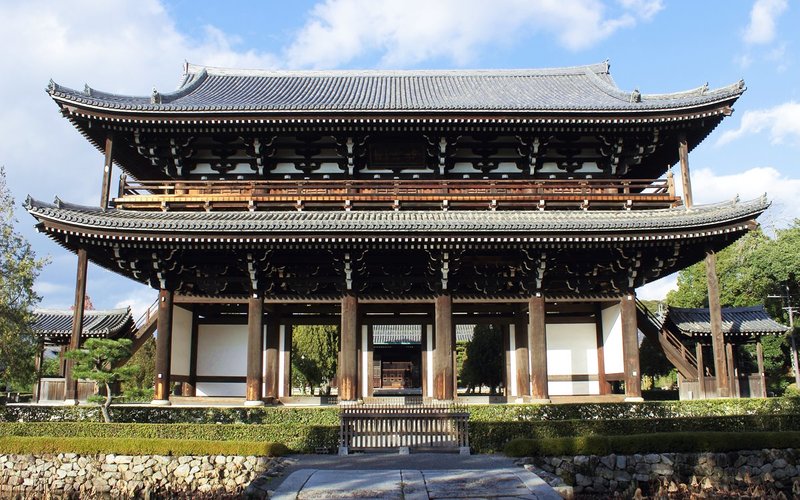
Tofuku-ji Temple, Fushimi Inari Taisha Shrine
Kyoto has many places famous for its beautiful autumn scenery, and one popular area is here at Tofukuji Temple and Fushimi Inari Taisha Shrine, where the valley is covered with fall leaves in a dazzling display.
The seemingly never-ending Torii corridor, the round windows of Funda-in Temple, and the beautiful fall scenery visible from the Tsuten Bridge at Tofuku-ji Temple are just a few of the tourist spots that have been immortalized in famous paintings.
Tofuku-ji Temple is said to be the best place to see fall colors in Kyoto, but it does not have any cherry trees, which are iconic to Kyoto.
It is said that an artist once made a special request to Ashikaga Yoshimitsu to remove the cherry blossoms because tourists and visitors who gathered for the cherry blossoms interfered with Buddhist practices at the temple.
The scenery of Japan’s oldest and greatest temple was said to be created to allow people to fully immerse themselves in prayers. Fushimi Inari Taisha Shrine has wonders beyond just its Torii gate.
Along the “oyama meguri” sacred pilgrimage at Mount Inari, there are numerous small shrines and charming rest areas, and you can see wonderful views overlooking Kyoto. The Inari Shrine specialty “oinarisan”, which is rice wrapped in deep fried tofu skin, and udon are sure to soothe your soul and fill your stomach.
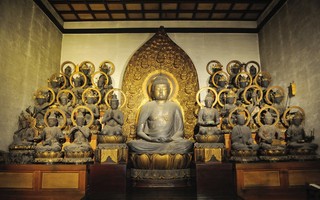
A Sokujo-in Temple
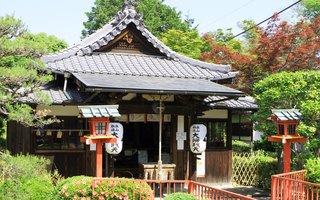
B Kaiko-ji Temple
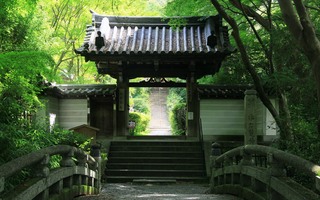
C Raigo-in Temple
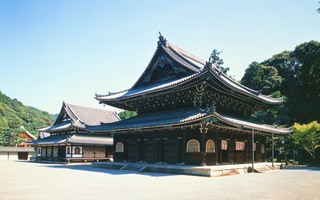
D Mitera Sennyu-ji Temple
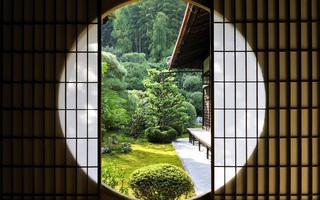
E Funda-in Temple

F Tofuku-ji Temple
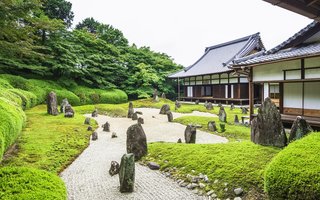
G Komyo-in Temple
H Fushimi Inari Taisha Shrine
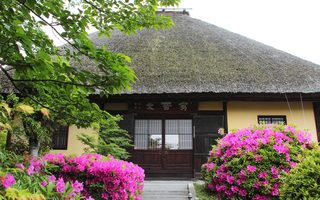
I Zuiko-ji Temple
A
Sokujo-in Temple

During a scene in The Tale of the Heike, Nasu no Yoichi from the Minamoto clan calmly speared an arrow through a target that was placed on a small ship.
The Battle of Yashima was one of the causes of the fall of the Heike clan, and its famous archer is said to have lived his last days here at Sokujo-in Temple. The Amitabha statue, which is said to represent the Sukhavati in this world, is 5.5 meters stall and is surrounded by 25 Bodhisattva that are each 150 centimeters tall.
When you visit, you will want to be sure to get an “aun-inu” charm, a wooden “ema” plaque that says wishing good luck, and in the fall you can get a special “shuin” seal called “koyo mau gokurakujodo”, or Sukhavati with autumn leaves.
You can grasp good fortune as you make your prayer, and you can gently pet the “aun-inu” dog statue during your visit.
B
Kaiko-ji Temple

If you include the 5.4 meter tall pedestal and back portion of the statue, the Buddha statue at Kaiko-ji Temple stands about 10 meters tall, making it the largest Buddha statue in Kyoto.
Said to have been created by the father and son team of Unkei and Tankei, this Buddha is known as “jorokusan” and is a famous representation of Guatama Buddha. It is said that the marks on his throat are blood from when Emperor Go-Mizunoo was the target of an assassination attempt, and Guatama Buddha took his place and saved his life.
If you wish to pray about avoiding catastrophe, an illness, or injury to the head, this is the place to do so.
Kaiko-ji Temple is also a place of worship for Monju Bosatsu (Bodhisattva), famous for a proverb meaning “two heads are better than one,” as well as the Buddhist image Senzan Yuzu Benzaiten, which is only shown to the public twice a year. Elsewhere inside the grounds you can find the resting places for three members of the Imperial Palace who were killed in the Aburanokoji Incident in an attack involving the Shinsengumi.
C
Raigo-in Temple

One of the sub temples at Sennyuji Temple deifies the guardian deity of the Three Jewels, a Buddhist concept introduced to Japan long ago from China by Kobo Daishi.
Legend tells of a “tokkosui” holy spring that Kobo Daishi is said to have unearthed. It gained fame when it healed the blindness of the daughter of a court lady whom the Emperor favored, and many people visit today with prayers concerning a wide variety of ailments.
In contrast to the vivid scenes of fall colors, there is also scenery where you can enjoy the traditional Japanese aesthetics of “wabi sabi” or the appreciation of transience and imperfection. You can walk along the garden until you reach the Gansuiken tea room that was constructed by Oishi Yoshio, all among the beautiful patterns of the fall leaves in the trees and on the ground. You can enjoy matcha tea in the same garden where the secret talks of the 47 Ronin took place, and at the same time you can enjoy the peaceful fall colors.
D
Mitera Sennyu-ji Temple

Sennyu-ji Temple has deep connections to the Imperial household. The name means temple of the flowing water, which comes from a tale about a clear spring bubbling from the corner of the land on which the temple is built.
As one of the top 66 places to see fall colors in Kyoto, this famous temple is visited by many people in the fall. Gozasho Garden is the perfect place to enjoy the fall colors.
Gozasho Garden houses the relocated empress’s residence from the old imperial palace in Kyoto, and it even has a maternity room. Today the Imperial household still uses the site as a vacation spot, and Emperor Showa enjoyed Japanese waka poetry here. If you pass through the large gate and look back to the left, you will see a Kannon temple with a Buddha statue of Yang Guifei, one of the three beauties of the ancient world, making this a popular site for women to visit with prayers regarding beauty. While the site is popular among women praying for beauty, safe childbirth, marriage, and so forth, the vibrant coral coloring of the statue is well preserved, and its beautiful appearance is a must see for men as well.
In addition to the Tsukinowa no Misasagi Mausoleum where many Emperors rest, you can also see Sennyu-ji Palace and a monument for Sei Shonagon, making this a great place to walk around as you view the fall colors.
E
Funda-in Temple

One of the sub temples of Tofuku-ji Temple, Funda-in Temple includes a traditional Japanese garden created by famous painter and Zen priest Sesshu.
As one of the oldest gardens in Kyoto, the stone work features images of the crane and tortoise, and it is also known as Sesshu-ji Temple.
It was largely destroyed by two fires and many long years of wear, but in 1939 it was restored by landscape architect Mirei Shigemori without bringing in a single outside stone.
The “Cha kanpaku” round windows are said to have been loved by Ichijo Ekan, and they look upon the East Garden designed by Mirei. The scene of the garden is said to reflect the heart of the viewers.
Funda-in Temple also offers Sesshu-ji Temple “shuin” seals and a monument for Ichijo Uchitsune, and you can get a seal featuring the name of the Ichijo family palace Tokaden.
F
Tofuku-ji Temple

As the largest and oldest Buddhist temple in Japan, Tofukuji Temple took 19 years to build, and with approximately 2,000 trees it is a preeminent spot to see the fall colors in Kyoto. During the abolition of Buddhism in the Meiji era, it was reorganized into a large temple with 25 sub temples. Some of the best views of the fall colors can be found at its three bridges. Engetsu Bridge, Gaun Bridge, and Tsuten Bridge are such amazingly scenic spots that at some times of year photography is prohibited and people are not allowed to access them. Looking upon the temple hall from Tsuten Bridge, the fall colors are magnificent. This site houses numerous important cultural assets that are worth seeing, such as the triple gate that is a national treasure, Japan’s largest Zen meditation hall where 400 Zen monks train, a checkerboard pattern of moss and stone in Hojo Garden, and more. One such important cultural asset is Japan’s oldest “tosu.” A tosu is a type of bathroom in a Zen monastery. This tosu has a width of 10 meters, making it usable by 100 people at once, and this size sparks stories about how large the temple must have been. During the fall season there are also special “shuin” seals. You can enjoy a modern garden and the fall colors together.
G
Komyo-in Temple

One of the sub temples of Tofuku-ji Temple, the beauty of the moss after a rain has given this temple an unusual nickname which means “rainbow moss temple.” It is famous for its azaleas, but the deep greens of the moss spreading throughout this traditional Japanese garden makes this an amazing site for quietly viewing the fall colors.
The traditional garden known as Hashin no Niwa was created by landscape architect Mirei Shigemori, combining the concepts of clouds, mountains, the moon, and waves and featuring an image of the ocean made from stone and sand.
Mirei Shigemori also created the tea pavilion Ragetsuan, and when looking from the main temple building out into the garden, you might be able to catch a glimpse of its moon shaped wall off to the right.
Looking out of the round windows in the room next to the main temple, you can see fall colors all around, providing yet another way to experience the scenery of the garden.
In the fall season you can also enjoy matcha tea and sweets, making this the perfect hidden spot for enjoying the fall colors.
The entrance fee is paid by making a voluntary donation into bamboo tubes. A donation of around 300 yen is good.
You can experience what it is like to escape from the hustle and bustle, and gaze out through the round windows upon the stone and sand ocean and azalea clouds with the moon visible overhead.
H
Fushimi Inari Taisha Shrine
Combining the beliefs for gods of an abundant harvest and a thriving business, this Fushimi Inari Taisha Shrine is the main temple for 30,000 “oinarisan”, the god of harvest and prosperity, around the country.
This elegant and brilliant main shrine is an important cultural asset, which was built in the Azuchi Momoyama period, and the red painted “torii corridor” attracts many visitors from Japan and abroad.
The total number of torii gates is said to exceed 10,000, and this tourist attraction is one of the best Instagram spots in all of Kyoto.
Starting from the rear shrine, you can walk the “oyama meguri” sacred pilgrimage at Inari Mountain.
During the walk you will come across Shin-ike Pond, where legend says that if you face the water and clap your hands, the direction that the echo comes from points toward the person you are searching for. If you are looking to improve your fortune, then Mitsurugisha is known as a power spot with spiritual energy. The full “oyama meguri” circuit is about four kilometers and takes two hours, so if you have the time you should hike all the way to the top.
I
Zuiko-ji Temple

Zuiko-ji Temple has a main hall with rounded thatched roof, which creates a serene atmosphere. Gensei Shonin, the high priest of Nichiren Buddhism, founded the temple, and it is famous for making and breaking relationships.
Visitors are able to make wishes not only about creating great relationships, but also breaking relationships, related to the tale of Gensei Shonin breaking his ties with the samurai family and forming new ties with Buddha. In Kyoto, where there are many ornate temples, there are few temples with thatched roofs, which is why it is recommended for those who want to enjoy autumn leaves in a quiet atmosphere.
In the main hall named Jakuon-do, there rests a seated Shaka Nyorai statue which is filled with markings that are in the form of the five organs. Also, there is Hakuryu Zeniarai Benzaiten where visitors can wish for good financial luck.
Gensei Shonin is said to be a monk who took very good care of his parents, and despite his own sickness, took care of his mother until she died at the age of 87.
Take a little walk at Zuiko-ji Temple if you would like to calmly encounter good luck, or break from bad luck.